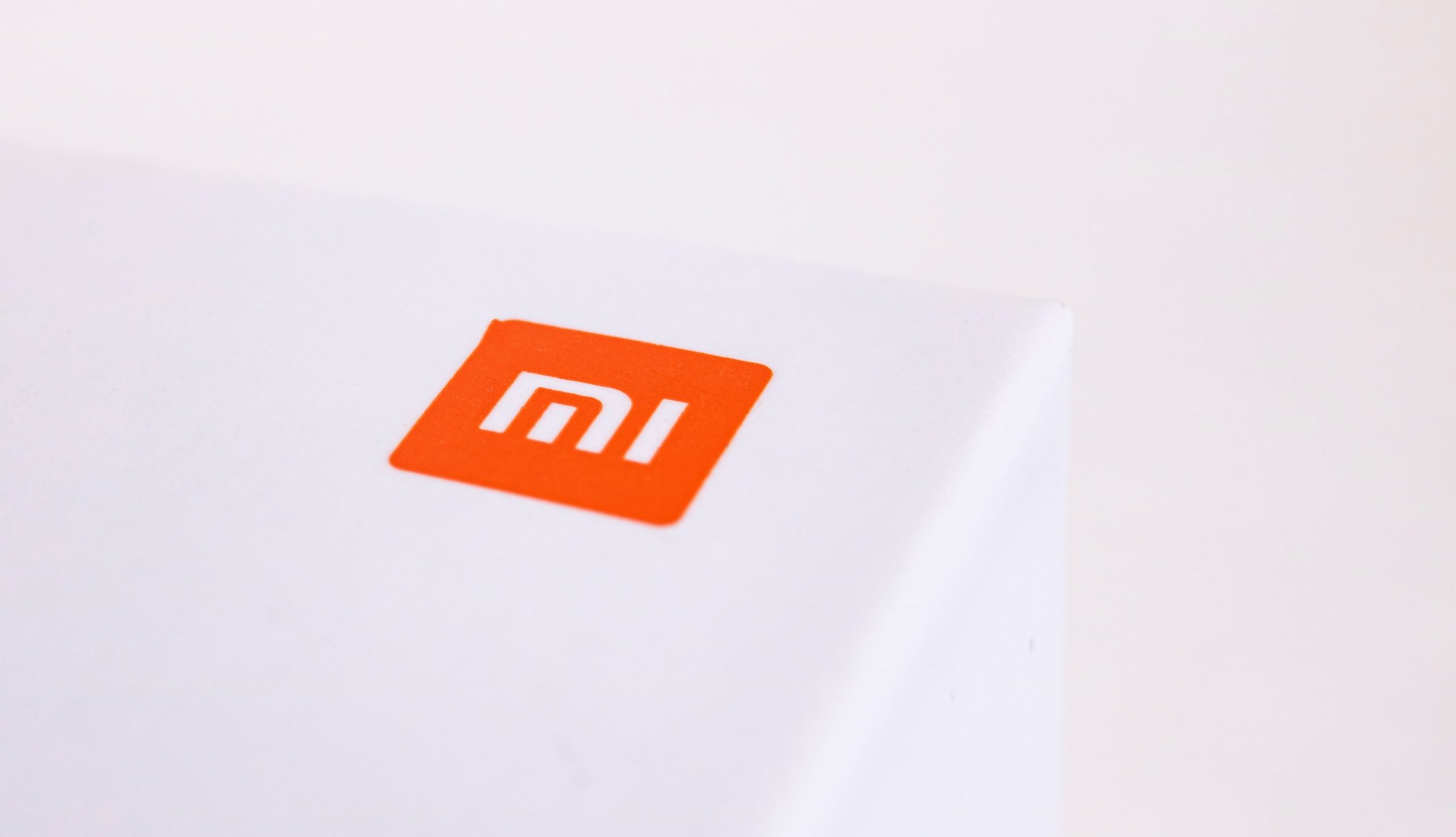Content marketing encompasses a wide range of tactics. Your website and blog are content marketing. So is your social media presence. Your YouTube videos are content marketing, too.
And while all of that great content helps bolster your digital marketing strategy, there is one tactic that delivers outsized results but is sometimes overlooked: interactive content.
In this guide, we’ll explain what interactive content is, share a list of common types, and fuel your inspiration with plenty of examples.
Content
What is interactive content?
Interactive content is anything that invites direct engagement from readers or viewers. It’s not about passively reading or watching. Instead, interactive content invites your audience to, well, interact!
Some brands shy away from interactive content because it can take more time to create. Unlike a blog post, which is pretty straightforward and can often be drafted and posted by your internal team, interactive content might require more support. For example, a custom quiz may need the assistance of a writer, designer, and web developer.
However, as online tools grow more sophisticated, there are drag-and-drop options that empower your team to create simple but effective interactive content.
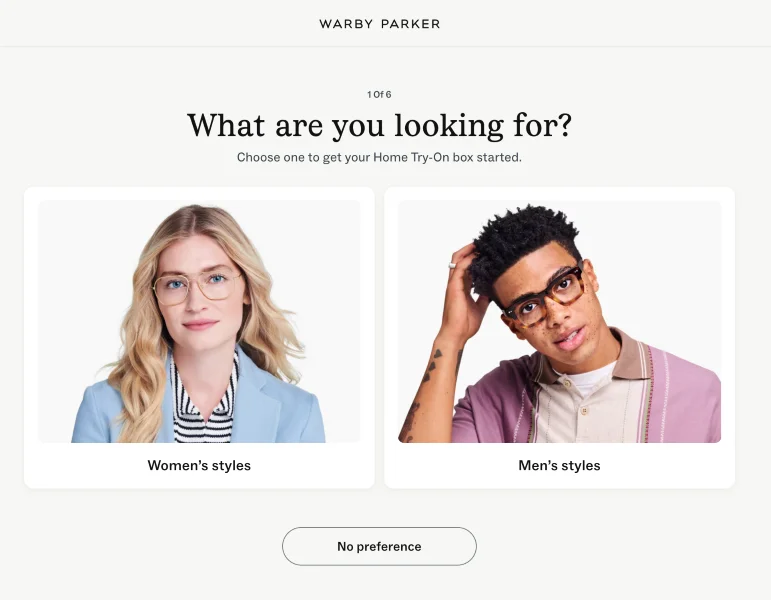
This quiz from glasses brand Warby Parker helps consumers find the perfect frames from the comfort of their own homes.
And even if there is extra effort, it often comes with a greater reward. Interactive content generates up to five times more views than its static counterparts and enjoys double the conversion rate.
12 types of interactive content to try
You understand the potential of interactive content, but perhaps you’re not sure where to start. You’ve come to the right place. Read on for a list of interactive content types to try, plus see real-world examples of different tactics in action.
1. Quizzes
If you were online in the aughts and 2010s, you likely remember the grip that BuzzFeed quizzes had on the culture.
Online quizzes are intriguing because they put the quiz taker at the center of the experience. A BuzzFeed-style quiz invites a user to discover something unique about themselves. Who doesn’t want to learn which Golden Girls character they are? This style of quiz encourages sharing—once you discover you’re a Dorothy, you want to tell your friends and see who’s the Blanche in your group!
Alternatively, online quizzes that test your knowledge are engaging because they allow the taker to aim for a high score and feel smart. These trivia-based quizzes often share how you stack up against others.
Finally, quizzes can serve as a sales tool. For example, DTC makeup brand Il Makiage uses its POWERMATCH quiz to help buyers find the right foundation shade—something that might otherwise be a hurdle for an online-only business.
The quiz makes it easy for prospects to identify their ideal shade and make a purchase they’ll be pleased with.
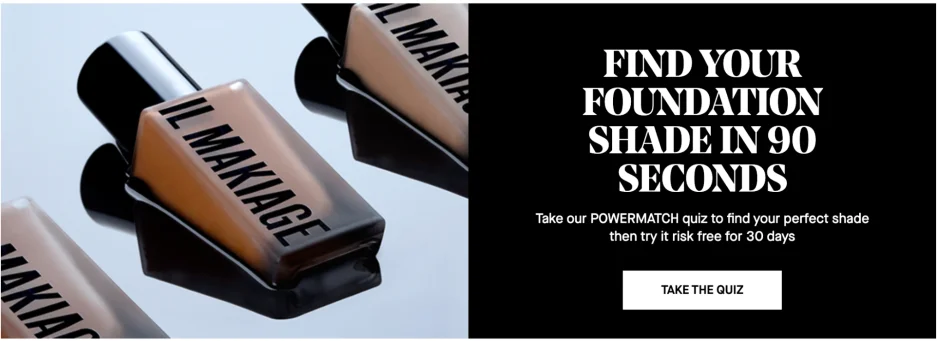

Source
💥 Let’s keep the leads flowing! Download 14 Fast & Easy Ways to Get Free Leads (+Examples You Can Copy)
2. Games
Like quizzes, games can be similarly attractive and addictive. As an example, The New York Times boasts over 10 million daily players of its word and logic games.
If games can create that kind of draw for a newspaper, they can do the same for you. And while games certainly require more development than, say, a simple survey or quiz, the investment can be worthwhile.
3. Calculators
Online calculators can be an incredible educational tool for your audience. This particular type of interactive content is great for brands that sell expensive or complex offerings. Customers might need additional education about the financial implications of making a purchase decision.
A classic example is a bank offering a mortgage calculator. Deciding to buy a home is one of the biggest financial decisions a person will make in their lifetime, so a calculator that helps them visualize the full cost implications of that decision can go a long way toward assuaging concerns.
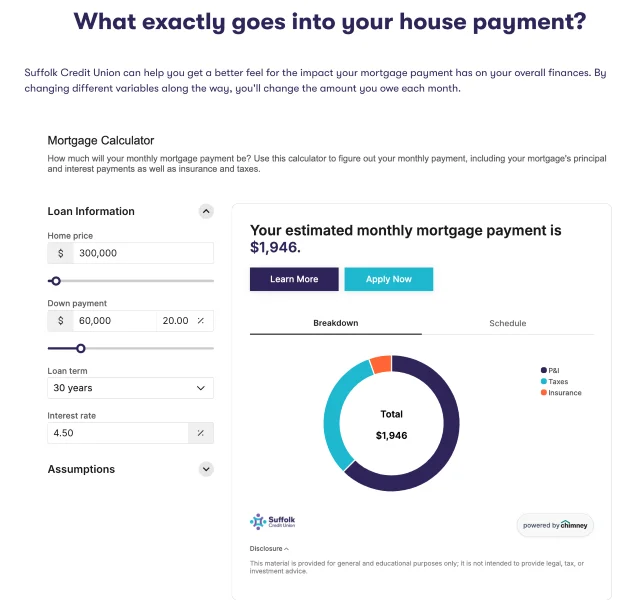

Suffolk Credit Union uses its mortgage calculator to help prospective homebuyers understand monthly costs.
Calculators can also work for B2B brands that sell a high-cost business solution. Typically, numerous decision-makers weigh in on a B2B buying decision, and the leaders will often want to know the costs and benefits of making a big purchase.
If you can create a calculator that accurately represents the ROI of purchasing your solution, you give B2B buyers greater assurance that your offering is worth the cost.
4. Polls
Comments sections, thumbs up, ratings—people love sharing their opinions online. Creating a poll is a form of interactive content that gives your audience another chance to make their voice heard.
Polls can be used just for fun to drive engagement, or they can help you gather customer insights and guide real business decisions.
For example, a DTC mattress brand might post an informal poll in its social media stories asking followers to share whether they’re a side sleeper, back sleeper, or stomach sleeper. The subsequent stories could then show the best mattress for each sleep position.
Alternatively, a business might use a poll to crowdsource information about a new product launch. As an example, a local restaurant looking to add entertainment to its evening schedule might ask its audience whether they’d prefer a trivia night, comedy show, or live music.
💡 Every piece of interactive content needs a great call to action! Get ideas to create your own in The 42 Best Call to Action Phrases Ever (& Why They Work).
5. Surveys
Surveys are another way for businesses to gather vital information from their audience. Surveys tend to be used for an explicit business purpose, like gathering feedback on a recent buying experience.
But a well-designed survey can encourage readers to complete it, even if it’s ultimately for your benefit. Fortunately, there are plenty of free online survey tools that can help any business launch an engaging survey.
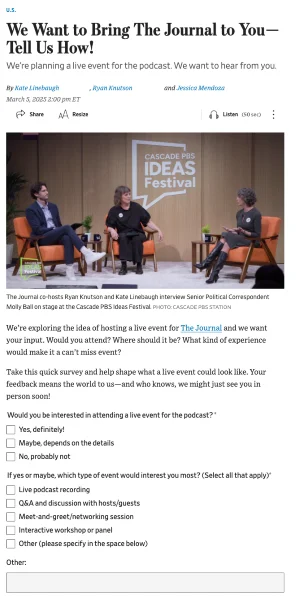

The Journal podcast wanted to collect feedback on a potential upcoming live event, and it created a survey to ask its audience what they’d like to see there.
Surveys are a great way to open the door to deeper conversations with your audience. At the end of a survey, you can invite the respondents to share contact information and indicate that they’d be open to more discussion. Even if you don’t connect directly, showing that you care about their thoughts makes your audience feel more seen and heard.
6. Assessments
Assessments fall somewhere between quizzes and surveys in the world of interactive content. While a quiz tends to be more lighthearted, an assessment is a tool with a bit more weight.
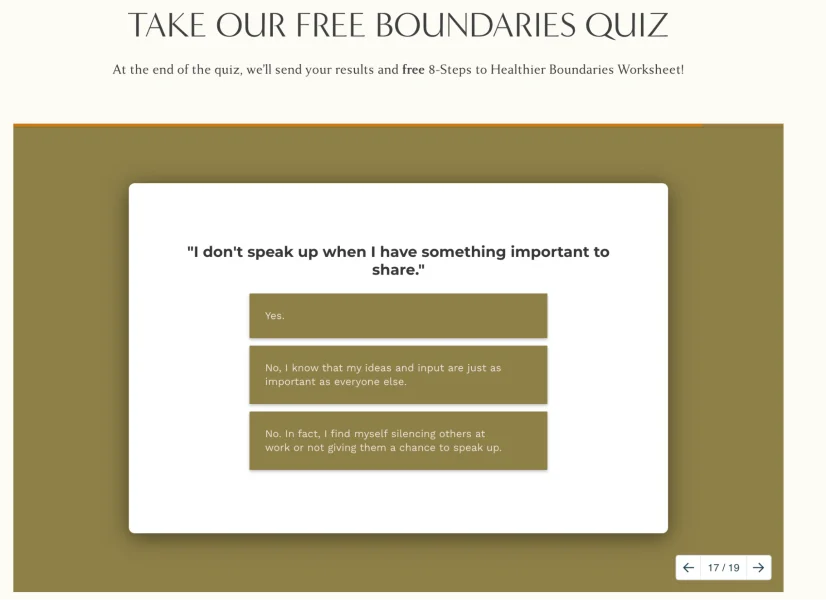

Therapist and author Nedra Glover Tawwab has several assessments available on her website.
Service businesses might use assessments to help prospective customers determine if they have an issue the business can solve. For example, a physical therapy office might create an assessment for athletes who are trying to decide if their injury requires professional help to heal. Or, a tutoring business might offer an assessment to help parents evaluate whether or not their children could benefit from some academic support outside the classroom.
7. Image sliders
Before-and-after images have long been a powerful marketing tool for showcasing certain products and services. If you’ve ever watched an infomercial, you’ve probably seen this technique used to demonstrate the power of the product being sold.


This example from a home renovation shows how the contractor transformed a dark and outdated bathroom on the right into a bright, modern, functional space.
Online, you can create interactive image sliders that align before-and-after photos, allowing viewers to slide between the two. As they do, they’ll see the impact of the business’s product or service.
This interactive content tactic can be applied in a variety of industries, from dental practices showcasing the results of a teeth whitening session to landscapers demonstrating the transformation of a scruffy backyard into a perfectly pruned oasis.
8. Maps
When you think of digital maps, you likely envision the Google Maps interface. But businesses can create interactive maps as part of their content marketing efforts.
Of course, these maps can be used to show your business’s physical footprint if yours is a multi-location operation. But interactive maps can serve other purposes, too.
For example, a travel brand that hosts safaris in Tanzania might create an interactive map that shows where in the national parks you might expect to see different types of wildlife. Or, a retail brand might create a map of its store, allowing customers to virtually browse and navigate the space.
9. Multimedia long-form content
Long gone are the days when a static PDF is your only option for presenting an ebook, whitepaper, or other type of long-form content to your readers.
Today, it’s possible to create interactive, multi-page documents with embedded videos, moving text, clickable images, and headers that open a pop-up with additional information, among other features.
By making your long-form content more dynamic, you encourage more active reading and less skimming. Slowing your readers down and engaging them throughout the paper helps showcase the full value of your long-form content.
10. Interactive video
Video is already a hugely impactful channel—HubSpot named short-form video the top content format, delivering high ROI in 2025.
By adding interactive elements to an already high-engagement channel, you can potentially strengthen its effectiveness. Interactive videos allow viewers to click on elements, see more details, and delve further into the topic.
As an example, a car dealership could create an interactive video showing off the latest model to hit its lot. For each new feature shown in the video, the dealership could add clickable pop-up text that gives even more information on the benefits and specs.
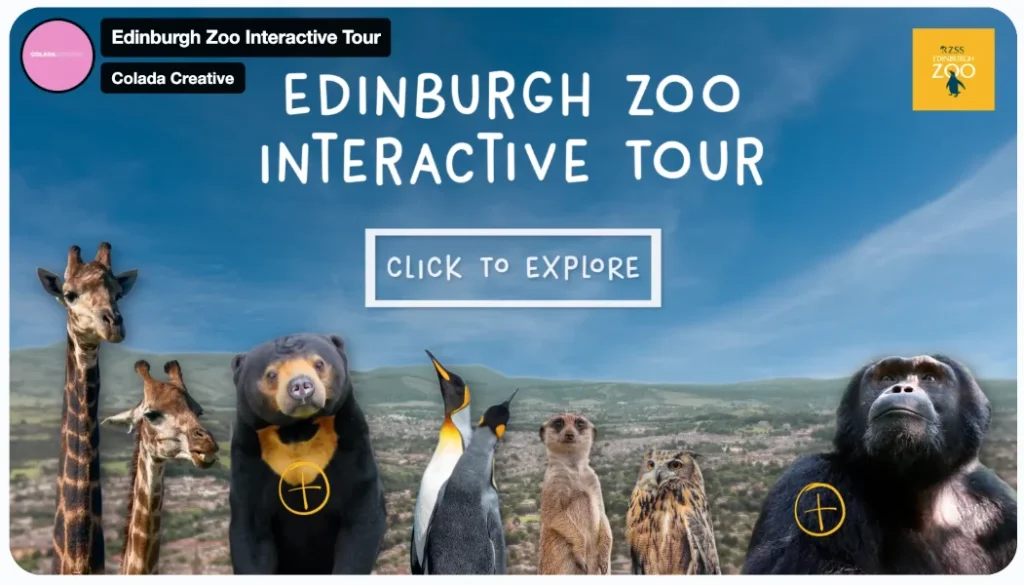

This interactive video from the Edinburgh Zoo invites viewers to choose their own adventure (would you like to see the sun bears or penguins first?) and to click to learn more about each animal along the way.
11. Interactive social content
Social media platforms know the power of interactive content, and that’s why many have incorporated interactive features for users to harness.
On Instagram and TikTok, you can add poll or quiz stickers to your Stories or videos. On LinkedIn, you can create and run a poll.
Including interactive content regularly on your social media content calendar keeps your audience engaged. It reinforces that your business’s social media page is a place for dialogue with you, and positions you as an approachable, friendly brand.
12. Augmented reality
Augmented reality (AR) won’t be right for every business, but there are certain industries where the technology is a natural fit.
Essentially, AR inserts a computer-generated image into a real physical space. On mobile devices, users can point their camera at the environment they’re in, and AR can add a digital image to the real world shown on the screen.


Source
Many furniture companies use AR tools to allow consumers to virtually try pieces in their homes before buying. In the example above from the IKEA app, you can see how users hold their camera phones up to the area where they want to see the furniture and then virtually place the couch, chair, or rug in their existing space.
Augmented reality is great for retailers who want to give their customers an opportunity to virtually try their products before they buy.
Using interactive content to build deeper connections with your audience
Interactive content, by its very nature, encourages your audience to engage more meaningfully with your brand. It creates space for two-way conversation in a way that static content simply can’t. And opening the door to dialogue helps establish your brand as a place your audience can go for advice and answers.
Even businesses with a limited marketing budget can take advantage of existing tools to start releasing interactive content. From social media polls to free survey tools, there are simple, low-cost ways to begin leveraging the power of interactive content today.







